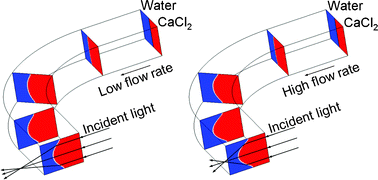In this work, we report the design, fabrication, and characterization of a tunable optofluidic microlens that focuses light within a microfluidic device. The microlens is generated by the interface of two co-injected miscible fluids of different refractive indices, a 5 M CaCl2 solution (nD = 1.445) and deionized (DI) water (nD = 1.335). When the liquids flow through a 90-degree curve in a microchannel, a centrifugal effect causes the fluidic interface to be distorted and the CaCl2 solution bows outwards into the DI water portion. The bowed fluidic interface, coupled with the refractive index contrast between the two fluids, yields a reliable cylindrical microlens. The optical characteristics of the microlens are governed by the shape of the fluidic interface, which can be altered by simply changing the flow rate. Higher flow rates generate a microlens with larger curvature and hence shorter focal length. The changing of microlens profile is studied using both computational fluid dynamics (CFD) and confocal microscopy. The focusing effect is experimentally characterized through intensity measurements and image analysis of the focused light beam, and the experimental data are further confirmed by the results from a ray-tracing optical simulation. Our investigation reveals a simple, robust, and effective mechanism for integrating optofluidic tunable microlenses in lab-on-a-chip systems.

You have access to this article
 Please wait while we load your content...
Something went wrong. Try again?
Please wait while we load your content...
Something went wrong. Try again?


 Please wait while we load your content...
Please wait while we load your content...